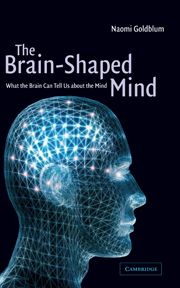Book contents
- Frontmatter
- Contents
- Preface
- Figure permissions and acknowledgments
- 1 Introduction
- 2 What the brain cannot tell us about the mind
- 3 How neurons form networks
- 4 Theories and models of how the mind functions
- 5 What are connectionist networks?
- 6 How our networks learn
- 7 Connecting the networks: how different things are related
- 8 Evidence for connectionist models
- 9 Two different types of memory
- 10 Coping with disaster
- 11 Practical implications
- 12 Criticism of connectionist theory
- Annotated references and suggested readings
- Index
7 - Connecting the networks: how different things are related
Published online by Cambridge University Press: 02 December 2009
- Frontmatter
- Contents
- Preface
- Figure permissions and acknowledgments
- 1 Introduction
- 2 What the brain cannot tell us about the mind
- 3 How neurons form networks
- 4 Theories and models of how the mind functions
- 5 What are connectionist networks?
- 6 How our networks learn
- 7 Connecting the networks: how different things are related
- 8 Evidence for connectionist models
- 9 Two different types of memory
- 10 Coping with disaster
- 11 Practical implications
- 12 Criticism of connectionist theory
- Annotated references and suggested readings
- Index
Summary
Word-association tests notoriously reveal that people have a tendency to say “dog” when the tester says “cat”, “low” when the tester says “high”, “potatoes” when the tester says “meat,” and “mother” or “son” when the tester says “father.” Yet the types of relation between these pairs of words are very different. Cats and dogs are both animals – members of the same category – just as meat and potatoes are both foods, and lions and tigers are both wild cats. Each pair is mutually exclusive, in the sense that no animal can be both a dog and a cat at the same time; if an animal is a cat, it is not a dog, and vice versa.
High and low, in contrast, are opposites. They are generally thought of as being at the ends of a continuum, but they are not mutually exclusive in the same way that dogs and cats are. That is, the same thing can be considered either high or low, depending on the context. For example, we may call a certain mountain high when we are speaking about it in the context of the other mountains in its vicinity that are lower than it, yet if we are speaking about the highest mountains in the world, we may call the same mountain low.
The relationship between parent and child is yet a different one. These are opposites in a different sense – if Leah is the mother of Simon, then Simon is the son of Leah. The relationship between Leah and Simon is directly linked to the one between Simon and Leah, but it is not the same one.
- Type
- Chapter
- Information
- The Brain-Shaped MindWhat the Brain Can Tell Us About the Mind, pp. 66 - 74Publisher: Cambridge University PressPrint publication year: 2001



